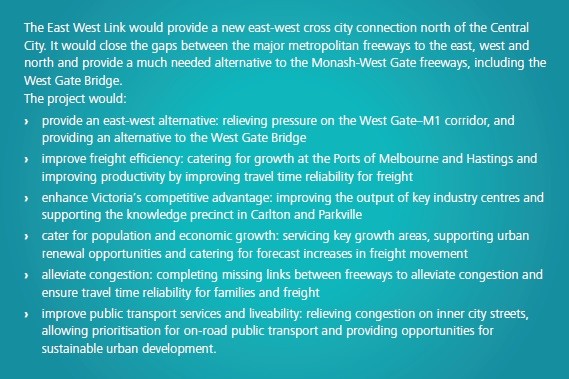
I almost choked on my muesli on Friday morning when I read in the paper that five of the six members of the Ministerial Advisory Committee on Melbourne’s new strategic plan had quit their commissions in protest over “key transport decisions”.
According to the report in The Age (Doubts over planning strategy after key advisers quit), the Committee’s key concern about the draft strategy, Plan Melbourne, is its commitment to “spending on the east-west link at the expense of improvements to the public transport network…”
The Age reports the Chair of the Committee, Professor Roz Hansen, appeared at a public meeting last week opposing the road. She’s quoted as saying:
Metropolitan road transport solutions used in the 1960s and 70s do not make a great 21st century city. The east-west concept and design is adopting old technology – it is not smart, innovative or progressive thinking.
The Herald-Sun ran the story prominently too (Former planning adviser hits out at Napthine Government over East-West Link and long-term strategy). It also quotes Professor Hansen:
This inner urban freeway project will undermine, erode and destroy part of our Royal Park… it is fraught with problems as well as showing a shortsighted and politically expedient approach.
This is another blow for the Government’s road plans. The East-West Link is looking more and more like a liability, especially compared to the Opposition’s politically astute promise to prioritise the Melbourne Metro rail line and remove 50 level crossings.
The resignations also raise questions about the role of advisory committees and the limits to their responsibilities and obligations. Advisory committees are ostensibly meant to offer advice, not call the shots. Governments are supposedly free to take their advice or leave it.
What surprises me is why the five Advisory Committee members left it until now to resign and why they did it in a blaze of publicity that maximises the embarrassment for the Government. I don’t find the offered justification entirely convincing.
I wonder what the members were expecting when they were appointed back in 2011; did they think they were working for The Greens?
The last (Labor) Government built the 27 km Peninsula Link and the 39 km EastLink freeways, plus freeway standard bypasses and freeway widenings. The Kennett Government before that built the 22 km CityLink freeway.
What on earth would make the Committee members think things would be completely different under a Liberal-National Coalition Government?
Maybe they were just naive. But then why didn’t they resign back in May 2012 when the Baillieu Government was reported to be “red hot” about building the East-West Link?
Or 18 months ago when Tony Abbott promised he’d provide $1.5 billion for the East-West Link if he won the election? (See Do new freeways signify progress?). Did they really imagine he’d made that promise without the agreement of the Victorian Government?
The Napthine Government’s intentions must’ve been pretty clear by early 2013 when it made the East-West Link its number one pick on Infrastructure Australia’s priority list (see Does this freeway make any sense?).
And any possible lingering doubts should surely have been removed back on May 7 when Mr Napthine announced the Government would formally “commit to funding stage one of this city-shaping project”. The Treasurer left no room for doubt:
The Coalition Government will call for Expressions of Interest later this year to deliver the project under a Public Private Partnership arrangement, with a view to awarding a contract in late 2014… Extensive background work has already been completed and we have identified a corridor for the eastern section.
And even if they’d somehow failed to notice that commitment and the ensuing public hubbub, why wouldn’t they have resigned by 9 October when Plan Melbourne was released publicly?
What also surprises me is why the Committee took such a tame line on the East-West Link in the Discussion Paper, Melbourne: let’s talk about the future, it produced in 2012 to kick-off the consultation process on the strategic plan.
The Discussion Paper was presented as having been prepared by the Advisory Committee at arms-length from the Minister yet, as I wrote on 29 October last year, it accepted the Government had:
already committed itself to a range of projects and policies like, for example, the East-West freeway, a new zoning system, and significant residential growth in the city centre.
The Discussion Paper says (page 82) there’s a need to “improve road capacity for traffic bypassing the Central City, including the East West Link”. It goes on to say there’s also a need to develop a “connected network of freight corridors, including…the East West Link.”
The exhibit shown above is on page 84 of the Discussion Paper. It provides a list of the East-West Link’s promised benefits, including relieving congestion, increasing efficiency and improving public transport. There’s no mention of its negatives though, or any suggestion that it isn’t “smart, innovative or progressive thinking”.
If the five members now think the East-West Link is an issue that warrants resigning over, it’s reasonable to ask why they gave it prominence in their Discussion Paper and why they highlighted its positives but not its downsides. If they felt pressured by the Government to paint a misleading picture, why didn’t they resign before it was published?
Anyone who accepts a public appointment knows from the get-go what their role is, the limits of their influence, and the philosophy of the Government. I don’t find the explanation offered to the media by the resigning members to justify their actions entirely convincing; I can’t help wondering if there might be more to it.








Crikey is committed to hosting lively discussions. Help us keep the conversation useful, interesting and welcoming. We aim to publish comments quickly in the interest of promoting robust conversation, but we’re a small team and we deploy filters to protect against legal risk. Occasionally your comment may be held up while we review, but we’re working as fast as we can to keep the conversation rolling.
The Crikey comment section is members-only content. Please subscribe to leave a comment.
The Crikey comment section is members-only content. Please login to leave a comment.